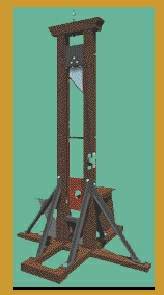|
PinkMonkey Online Study Guide-World History
The Constitution of 1791 was drawn up by the National Assembly, which assumed the title of the Constituent Assembly. The Constitution of 1791 was the first written constitution of France. It established a constitutional or limited monarchy and was based on the principle of separation of powers.
A unicameral legislature was set up, called the Legislative Assembly and it consisted of 745 members, indirectly elected for two years by all "active citizens".
The Constitution of 1791 provided for a hereditary king with the power to appoint ministers, but not to form the Legislative Assembly. The Ministers could not sit in the Legislature. The king had a "suspensive veto" to suspend an act of the Legislative Assembly for six years, but he could not dismiss the Assembly.
The judges were to be elected. There was to be a jury for criminal cases and a Supreme Court to be set up in Paris. Other courts were also set up.
(v) France was divided into 83 departments for administrative convenience and efficiency. These were further subdivided into districts, cantons and communes. Elected officials would replace the royal officers in administrative work.
Louis XVI decided to flee to Germany owing to his loss of power.
However he was caught and brought back to Paris where he took an
oath to support the Constitution. The National Assembly was dissolved
on September 20, 1791 and election to the Legislative Assembly were
held.
The Legislative Assembly, consisting of 745 members, met on October 1, 1791, and represented three political parties. The Constitutionalists were in favor of a constitutional form of government. The Girondists were moderates who wanted a republican form of government. The Jacobins were republicans of the extreme type. The king vetoed certain laws passed by the Legislative Assembly which suspended the king on August 10, 1792, and also the Constitution of 1791.
King Leopold II of Austria and the King
of Prussia decided to invade France, in order to restore the
Bourbon monarchy. France declared war on Austria and Prussia on
April 20, 1792, and inflicted a crushing defeat on its enemies on
September 20, 1792. On receiving the news of the French victory,
the National Convention was called on September 21, 1792, to prepare
a new constitution. It proclaimed the First French Republic on September
22, 1792.
King Louis XVI was found guilty of high treason by the
National Convention and was guillotined on January 21, 1793.
After the execution of King Louis XVI, the first coalition consisting of England, Holland, Spain, Sardinia, Austria and Prussia was formed against the First French Republic. However, it was completely smashed by the French armies under their military leader Carnot.

Exhibit 7.2
The contraption of the guillotine
The National Convention entrusted all executive authority to the "Committee of Public Safety", consisting of 12 members led by Robespierre. It let loose a ‘reign of terror’ in France, from 1793 to 1794. During this period royalists and others as Marie Antoinette, Danton, St. Just and Madame Rolland were guillotined. About 2,500 people were guillotined in Paris and about 10,000 people, in other parts of France. In the words of Madame Rolland, "O liberty, what crimes are committed in they name!" The ’reign of terror’ came to an end with the revolt of the Parisian mob against Robespierre who was guillotined on March 13, 1794.
After the ‘reign of terror,’ a committee of nine members was appointed by the National Convention to draft a new constitution. After ruling France from 1792 to 1795, the Convention was dissolved and the new constitution came to be called the Constitution of the Year Third (1795). It provided for a bicameral legislature, entrusted with legislative work. The executive authority was vested in the hands of a Directory of five, chosen by the legislature. The Directory appointed Napoleon Bonaparte, to deal with the invading armies. When the domestic affairs of France deteriorated and the government was almost paralyzed, the legislature was dissolved by a coup d’etat and Napoleon Bonaparte became the supreme master of France.
[next page]
|